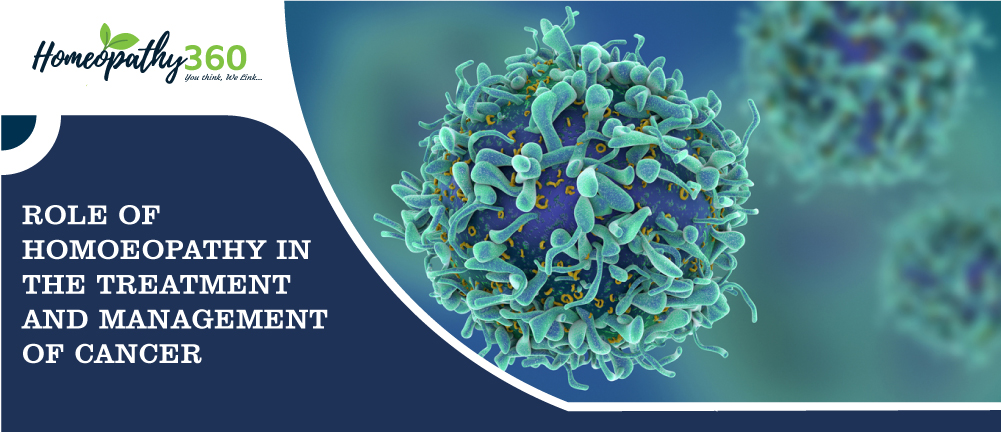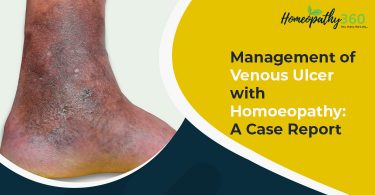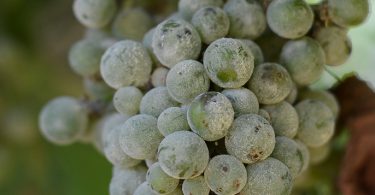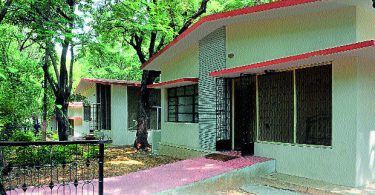
Keywords: Cancer–definition–causes–host factor–carcinogenic factors–viruses–clinical presentation – diagnosis – prevention – homoeopathic management – therapeutic aim – scope & limitation.
Introduction:
Cancer is still a burning problem in medicine. In-spite of regular research and modern development of medical science, techniques of diagnosis and treatment of Cancer, it is the 3rd common cause of death where as 1st due to intervention by medicine, 2nd is heart attack.
History & Authority:
The word ‘cancer’ came from Greek ‘karkinos’ means ‘crab or tumor’. Hippocrates and Galen noted the similarity of ‘cabs’ to some tumors with swollen veins.
The oldest documented case of cancer from Egypt in 1500 B.C. Details were recorded on Papyrus, documenting eight cases of tumors on the breast and was treated by cauterization, which destroyed tissue with a hot instrument called ‘The fire drill’ and also recorded that there was no treatment palliation is the only method of treatment. There is evidence that the ancient Egyptians were able to tell the difference between malignant and benign tumors. According to inscriptions, surface tumors were surgically removed in a similar manner as they are removed today.
Definition:
Cancer is a disease of uncontrolled division of abnormal cells and destroy of body tissues in any parts of the body, as a malignant growth or tumor that is hard to it’s contain and eradicate.
The reasons are:
- No specific causative agent not yet discovered.
- Rapid progress of the disease.
- Local and systemic metastasis.
- Associate complications like hemorrhage, secondary infection, malnutrition, severe anaemia, exhaustion, cachexia, obstruction by the growth, perforation, dehydration, ureaemia etc.
- Lack of awareness of the common people about the nature of disease and role of preventive measures in time.
- As a degenerative, destructive stage cancer appears as an ultimate. If even an early diagnosis fail to produce any desired result, excepting probably in breast and uterine cancer.
We as homoeopaths must keep in mind the basic fact that cancer is an ultimate of a series of inherent disease processes, be it in the beginning or end.
Aetiological cause:
There are many etiological theories relating to different clinical types including role of viruses in cancer, but no one yet accepted. However, two factors popularly accepted by modern medicine are:
- The host factor.
- The carcinogenic factor.
Causes of death in cancer:
- Obstruction by the growth.
- Perforation of an organ by local invasion and infiltration of cells, tissues.
- Severe hemorrhage.
- Severe malnutrition, cachexia and exhaustion.
- Increase susceptibility to intercurrent infection.
- Severe dehydration and uraemia.
- Systemic metastases in liver, lungs, heart, brain etc.
Carcinogens are playing an important role in the causation of cancer, but the host factor is more important. Because, the same dose of carcinogenic cannot cause cancer in all.
Host Factor:
In homoeopathy, hereditary miasmatic dyscrasia is responsible for hyper-susceptibility towards diseases.
- In cancer, the patient remains hereditarily susceptible or prone to develop cancer if and when exposed to carcinogenic influences, which as an exciting factor in patient having pre-carcinogenic predisposition.
- The miasmatic dyscrasia as stated above may also be acquired from uncured or maltreated chronic diseases resulting in suppression of the disease manifestations and transformation of the same into miasmatic states.
- Cancer is a manifestation of mixed miasmatic state in most cases.
- We may correct the hereditary or acquired miasmatic dyscrasia with our constitutional anti-miasmatic medicines.
- We can prevent it at least some extent and this is the best solution of cancer and pre-cancerous stages and the success depends on the stage of the disease and the efficiency of the physician to administer constitutional medicines judiciously in appropriate potency and doses.
Cancer as an incurable disease just by its name and biopsy report is not the principles of homoeopathy.
- ‘Treat the patient, not the disease’ is the basic in homoeopathy and cancer is not exception to this.
- No doubt the cancer is one of the most difficult diseases to treat and manage to cure, but that is due to its nature of growth, distant metastases and complications.
- Otherwise, it is to be treated in the same way as tuberculosis, diabetes, bronchial asthma or any other chronic diseases.
Common Carcinogens are:
Cigarette smoking, Benzene, Asbestos, Nickel, Arsenic, Cadmium, Naphthalene, Nitrite, Chromium, Uranium, Vinyl chloride, Radiation in any form, Drug alkalizing, immune-suppressive drugs, also hormones and coal, tar ointments etc.
Role of Viruses:
Some viruses are found to be associated with cancer. Epstein Barr Virus (EBV) with Naso-pharyngeal cancer, Burkitt’s lymphoma and Infectious mononucleosis. C – type RNA virus with leukaemia and sarcomas.
Clinical Presentation:
- Persistent palpable lump in breast not yielding to medical treatment.
- Palpable mass or persistent enlarged gland anywhere in the body.
- Painless, intermittent, easy bleeding from any site or organ.
- Non healing ulcer.
- Persistent dysphagia.
- Sudden alteration in bowel or urination habit like urge of stool at odd time, unable to control urge of urine even for few minutes etc.
- Persistent irritating cough or hoarseness.
- Sudden change in a wart or mole.
- Persistent anaemia, or emaciation without any apparent cause.
- Long continued temperature not responding by regular treatment.
Confirmatory Diagnosis:
Biopsy of the affected tissue or organ with bone-marrow.
Principles of Management:
PREVENTION:
By take care of the host factor:
From the childhood of the patient, deficient response of the immune system against any exogenous or endogenous disease producing stimuli, results in hyper-susceptibility towards any particular nosological condition.
- Inherited miasmatic dyscrasia being responsible for immune deficiency which is further influenced by various environmental factors, unhygienic mode of living and psychological trauma.
- So, we are to take care of the miasmatic dyscrasia by anti-miasmatic treatment from the childhood.
- Then come into balance diet, proper regimen and hygienic mode of living.
- Mental shock, grief, worries, anxieties, reserved displeasure, disappointments etc. play important role in turmoiling the system as a whole.
- Hence, psycho-analysis, friendly exhortations, helpful suggestions etc. are absolutely necessary in the prevention and management of cancer cases. For diet, green vegetables, vitamin C, containing fruits are helpful in prevention of malignancy.
- Adulterated and artificial foods are to be avoided as possible.
- For regimen, regular walking in open air, jogging, free hand exercise, avoiding night watching may helpful for raising resistance.
To avoid carcinogenic agents:
Smoking, chewing tobacco, carcinogenic chemicals, immune-suppressive drugs, unnecessary radiation is to be avoided so far as possible.
- Persistent irritation, both mental & physical are to be avoided like chewing of betal leaves, irritation of cheek or tongue by a broken tooth, long mental worries, tension etc. are to be avoided.
- To avoid suppression of chronic disease, skin diseases, warts, moles, ulcers etc.
- To avoid suppression of emotional outbursts, weeping, crying, laughing an outlet and saving nervous system from trauma.
- To take care of any persistent growth, ulcer, wart, mole, keloid etc. when its change their character suddenly.
- To take proper care of the pre-cancerous states by constitutional treatment and regular follow-up.
Homoeopathic Management in established cancer cases:
- Firstly to decide the possibility of surgical removal of the growth or ulcer.
- In case of localized growth and ulcer where lymph nodes are not involved or no such systemic metastasis takes place, there surgery is the ideal choice.
- Successful surgery may prolong the life of the patient.
- Post-operative constitutional treatments to eradicate the miasmatic dyscrasia to be continue.
- In in-operative cases as like carcinoma of liver, head of pancreas, lungs, oesophagus etc. where palliative mode of treatment to be needed.
- Anti-miasmatic treatment here contraindicated.
- Symptomatic palliation along with special diet, regimen and psychotherapy are the choice. Sufficient care to given-up the case may nicely improve the case and then constitutional treatment may safely be started.
- Peaceful death, prolongation of life and a meaningful existence may be the result of such treatment.
- Management in complications: Blood transfusion for severe anaemia, artificial feeding for severe malnutrition, I.V. fluid therapy in dehydration, palliative surgery to checking repeated bleeding, tracheotomy in respiratory distress etc. and any auxiliary measures to be adopted as and when necessary along with medicinal treatment.
- In far advance cases, when death is imminent or inevitable, suitable palliation by symptomatic medicines and euthanasia may be follow.
- Homoeopathic concept: In healthy condition normal physiology are going on harmoniously.
- In cancer this harmony become lost, chaotic state began, cells are dividing, and growth are on own way, and destruction is the outcome.
- Syco-syphilis state is responsible for this chaos, and anti sycotic and anti sythilitic and mixed miasmatic medicines are necessary as-per needed like nit.ac., thuja, nat.sulph., caust., lach., medo., kali group, carcinosin, tuber., etc.
- Doses and potency: 50-Millesimal (LM) potency is the best with frequent repetitions and necessary scopes for changes, to avoid any untoward aggravation.
- Centesimal potency may try with beneficial and long lasting result.
Conclusion:
There are no such reliable statistical documents to claim the efficacy of homoeopathy in cancer. If clinical research works are undertaken seriously with responsibility in Government or organized privet level as per reliable knowledge of classical homoeopathy then we claim and say on the subject. Till then, we must cautious to use the term ‘cure’ in case of cancer only on our individual experience. There are many fallacies of experiences and many improved cases may again relapse. Therefore, homoeopathy with conventional treatment should take side by side to see if joint venture may better in result for facing the problem of the killing disease the CANCER.
Few list of Medicines with their Miasmatic Cleavage:
Abrotanum P++ Syco++ Tuber++; Acetic acid P+ Tuber+(KCB); Aesculus hip.Syco+; Agaricusmusc.P++(H)Syco++ Tuber++; Aloe soc. P+; Alumen P+ Syco+; Alumina P++(H) Syco++(+K) Tuber++; Ambragrisia P+; Ammonium carb.P++(H) Syco++ Tuber+; Ammonium mur.P+(H) Syco+; Anacardium P++(H) Syco+ Tuber+; Antimonium crud P++(H) Syco++(+K); Antim tart.P+ Syco+; Apismell.P++ Syco++; Aranea Syco+; Antimoni Syco+; Argent met. P++ Syco++(+++K) Syph+; Argent. Cyanatum P++; Argent.Nit.P++ Syco++(+++K) Tuber+; Arnica mont. Syco+; Ars.alb.P+++(H) Syco++ Syph++ Tuber++; Ars. Iod.P+++ Syco+++ Syph+++ Tuber++; Ars.Sulph.flotusSyph++; Asteria rub.Syco++; Aurum met.P++(H) Syco++ Syph+++ Tuber+; Aurummur.P+(H) Syco+ Syph+++; Aurummur. Nah.Syph+++; Badiaga Tuber+; Barya carb.P++(H) Syco++ Syph++ Tuber+++; Barytamur.P+ Syco+; Belladonna P+; Benzoicum acid P+ Syco+ Syph+ Tuber+; Berberis vulg.P+ Syco+;BismuthSyco+ Syph+; Boracicum acid P+; Borax P++(H) Syco++; Bovista P+ Syco+; Bromium P+ Syco+; Brynia alb.Syco+; Bufo r. P++ Syco++ Tuber+; Caladium Syco+;Calc.carb. P++(H) Syco++ Tuber++; Calc. ars.P++ Syco++ Syph++ Tuber++;Calc. phos. P++ Syco+ Syph++ Tuber++; Calc. sulph.P++ Syco+ Syph++ Tuber++; Capsicum P++(H) Syco++(+K) Syph++ Tuber+++; Carbo. Veg. P++(H) Syco+ Syph++ Tuber++; Carboniumsulph.Syco+; CausticumP+++(H) Syco++ Syph+ Tuber++; Chamomilla Syco+; Cimicifuga. Syco++; Cina Syph++; Cinnabaris P++ Syco+ Syph++; Cistus P+ Tuber++; Clematis P+(H) Syco+Syph++; Coccuscact.P+ Syco+; Colcheicum Syco++; Colocynthis P(H); Conium m.P++(H) Syco++(+K) Syph+(++K) Tuber+; Corallium rub.Syph+; Croralushar.P+++ Syco++ Syph+ Tuber+; Croton tig.P+; Cuprum met.P+(H);Digitalis P++(H) Syco++; Dulcamara P+(H) Syco++ Tuber+; Euphorbium P(H) Syco+; Euphrasia Syco+; Ferrum met.P++ Syco++ Tuber++; Ferrumphos.P+; Fluoricum acid.P++ Syco++ Syph+++(++K) Tuber++; Graphites P+++(H) Syco+++(++K) Syph+++ Tuber++; Guicam P(H) Syph+; Helleborusnig.Syco+; Heparsulph.P+++(H) Syco+++(+K) Syph+++(++K) Tuber+; Hydrastis P+; Iodin P+++(H) Syco+++(++K) Syph++ Tuber++; Kali ars.Syph++; Kali bi.P++ Syco++ Syph++ Tuber+; Kali brom.P+ Syco+; Kali carb.P++(H) Syco++(+K) Syph++ Tuber++; Kali chl.Syph++; Kali iod.P++ Syco+++ Syph+++ Tuber+; Kali mur.Syco+; Kali nit.P+; Kali phos.P+Tuber+; Kali sulph.P+ Syco+++ Syph+++; Kreosotum P++ Syco++ Syph++ Tuber++; Lac can.P++ Syco++ Tuber++; Lac de.P+; LachesisP+++ Syco+++(++K) Syph+++(++K) Tuber++; Ledumpal P+ Syph++;Liliumtig. Syco+; Lycopodium P+++(H) Syco+++(++K) Syph++ Tuber+++; Mag. Carb.P++(H) Syco++ Tuber++; Mag. Mur.P++(H) Syco++ Tuber++; Mag. Phos.P+; ManganumP+(H) Syco++ Tuber+; Medorrhinum P++ Syco+++ Syph++; Mercurius P++ Syco++(+K) Syph+++; Merc. Cor.Syco+ Syph+++; Merc.Iod.Syco+; Mez.P++(H) Syco+++(++K) Syph++; Mur. AcidP+(H) Syco+ Tuber+; NajaP++ Syco++ Tuber++; Nat. ars.P++ Syco++; Nat. carb.P++(H) Syco++; Nat. mur.P+++(H) Syco+++(++) Tuber++; Nat. sulph.P++ Syco+++ Syph+ Tuber++; Nit.Acid.P++(H) Syco+++ Syph+++ Tuber++; Opium P+ Syco+; Origanum P++; Ostrya Syph+; Petro.P++(H) Syco++(+K) Syph+; Phos. Acid.P+(H) Syco+ Syph++ Tuber++; Phos.P++(H) Syco++ Syph++ Tuber+++; PhytolaccaP++ Syco++ Syph+++; Pichi P+ Syco+; Platinum P+(H) Syco+; Plumbum P+ Syco+; Podophyllum P+ Syco+; Psorinum P+++ Syco+++ Syph++ Tuber++; Pulsatilla P+ Syco+; Pyrogenium P+Syco+++ Syph++ Tuber++; Rananculus b. P+Syco+; Rhododendorn P+ Syco+; Rhustox.Syco+; Rumex c. P+ Tuber+; Ruta g. P++Syco++; Radium P+Syco+++Syph+++ Tuber+; Sabina P+Syco+; Sanguinaria P+Syco+ Tuber+; Sanicula P++Syco++ Tuber+++; Sarsaperilla P++(H)Syco+++Syph++ Tuber++; Secali cor. P+++Syco+(++K)Syph+; Selenum P++Syco++; Senecio a. P+Syco++ Tuber++; Senaga P+ Tuber++; Sepia P+++(H)Syco+++Syph+ Tuber++; Silica P+++(H)Syco+++(++K)Syph++(+++K) Tuber+++; Spongia Tuber++; Stannum P+(H)Syco+Syph++ Tuber++; Staphysagria P++Syco+++Syph++ Tuber++; Stillingia s.Syph+; Stramonium P+Syph+++; Sulphur P+++(H)Syco++Syph++ Tuber++;Sulph. Iod.Syph++; Sulph.Acid. P+(H)Syph+ Tuber+; Symphytum P+Syco+ Syph+++ Tuber+; Tarentula cub.P++Syco+++ Tuber+; Tarentulahisp. P+; Tellurium P+; Theridion P+; Thuja P++Syco+++Syph++ Tuber++; Thyroidinum P+; Tuberculinum P+++Syco+++Syph+++ Tuber+++; Vanolinum P+Syco++ Tuber+; Veratrum alb. P+Syco+; ZincumP+++(H)Syco+ Tuber+
Abbreviation: H = Hahnemann; K = Kent; KCB = K.C. Bhanja; P = Psora; Syco = Sycosis; Syph = Syphilis; Tuber = Tubercular.
Bibliography:
- Boericke W, Organon of Medicine; S. Hahnemann, translated by R. E. Dudgeon; Indian edition, Calcutta, Roy Publishing House, 1961
- Kent J.T., Lectures on Homoeopathic Philosophy; Memorial edition,New Delhi, B. Jain Publishers Pvt. Ltd, 1990
- Roberts HA, The Principles and Art of Cure by Homoeopathy, New Delhi, B. Jain Publishers Pvt. Ltd, 1992
- Close Stuart, The Genius of Homoeopathy; B. Jain Publishers Pvt. Ltd., New Delhi, August 2002
- Dey S.P., Essentials of Principles and Practice of Homoeopathy; Published by: Dr. Mrs. Sabita Rani Dey, CJ-325, Sector II, Bidhan Nagar, Calcutta – 700091; November 2000
About Author:
Prof. (Dr.) Goutam Das M.D. (Homoeopathy)
HOD, Dept. of Organon of Medicine, NHC&RI, Junagadh, (Gujarat)
Assist by:
Dr. Manimala Pramanick M. D. (Homoeopathy)
Asst. Prof. Dept. of Homoeopathic Pharmacy, NHC&RI, Junagadh, (Gujarat)
Dr.Annu Patel B.H.M.S.




